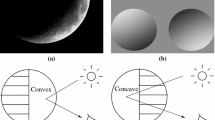Abstract
A paradigm for image interpretation and object extraction that deals explicitly with the levels of abstraction of such processes is described. The central new feature of this paradigm is two intermediate-level processes that deal with construction of symbolic image tokens and with symbolic descriptions of quantities. These intermediate-level processes have access to digital data but produce symbolic, abstract tokens and descriptions. The object extraction system is controlled by a higher-level symbolic process that uses knowledge-based reasoning.
To demonstrate this paradigm of reasoning according to levels of abstraction, we present its description in the limited domain of road-finding on aerial photographs. This example is followed in detail from the construction of line segments and uniform blobs, which are intermediate-level tokens, to the construction of contextual road segments from these tokens.
Similar content being viewed by others
References
Boldt M, Weiss R (1987) Token-based extraction of straight lines. COINS TR 87–104, University of Massa-chusetts at Amherst, October
Brooks RA (1981) Symbolic reasoning among 3-D models and 2-D images. Ph.D thesis, Stanford University
Canning J, Kim JJ, Rosenfeld A (1987) Symbolic pixel labeling for curvilinear feature detection. TR-1761, Center for Automation Research, University of Maryland, January
Draper B et al (1989) The schema system. International Journal of Computer Vision, 2:209–250
Fischler MA, Tenenbaum JM, Wolf HC (1984) Detection of roads and linear structures in low-resolution aerial imagery using a multisource knowledge integration technique, Computer Graphics and Image Processing, 15:201–223
Fua P, Hanson AJ (1987) Resegmentation using generic shape: Locating general cultural objects. Pattern Recognition Letters 5:243–252
Hanson AR, Riseman EM (1987) VISIONS: A computer system for interpreting scenes, In: Computer Vision Systems, AR Hanson and EM Riseman (eds) New York: Academic Press, pp. 303–333
Huertas A, Cole W, Nevatia R (1989) Using generic knowledge in analysis of aerial scenes. In: Proceedings of International Joint Conference of AI, Detroit, pp. 1642–1648
Kohl CA et al (1987) Goal-directed control of low-level processes for image interpretation. COINS TR 87-31, University of Massachusetts at Amherst, April
McKeown DM, Harvey WM, McDermott J (1984) Rule based interpretation of aerial imagery. In: Proceedings of IEEE Workshop on Principles of Knowledge-Based Systems, December, pp 33–39
Meisels A, Bergman S (1988) Finding objects on aerial photographs: A rule-based low level system. In: Proceedings of CVPR88, Michigan, June, pp 118–123
Meisels A, Hason O, Hess H (1991) Quantification and abstraction: Low level tokens for object extraction. Image and Vision Computing (in press)
Mintz D, Meisels A (1990) Symbolic reasoning about object extraction. Computer Vision Graphics and Image Processing, 52:447–459
Riseman E, Hanson A (1986) A methodology for the development of general knowledge-based vision systems. COINS TR 86-27, University of Massachusetts at Amherst, July
Author information
Authors and Affiliations
Rights and permissions
About this article
Cite this article
Meisels, A. Levels of knowledge for object extraction. Machine Vis. Apps. 4, 183–192 (1991). https://doi.org/10.1007/BF01230200
Issue Date:
DOI: https://doi.org/10.1007/BF01230200




